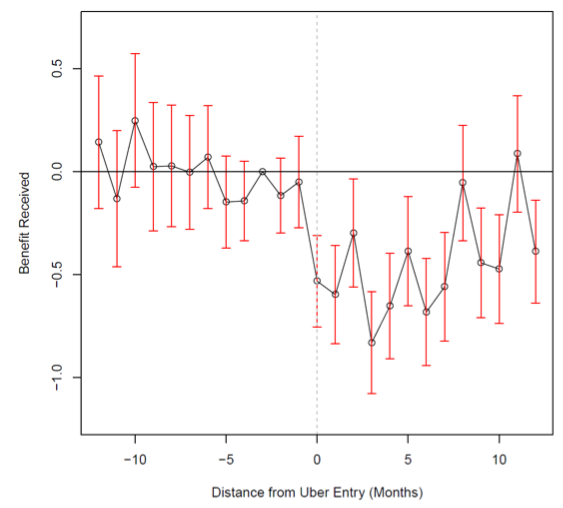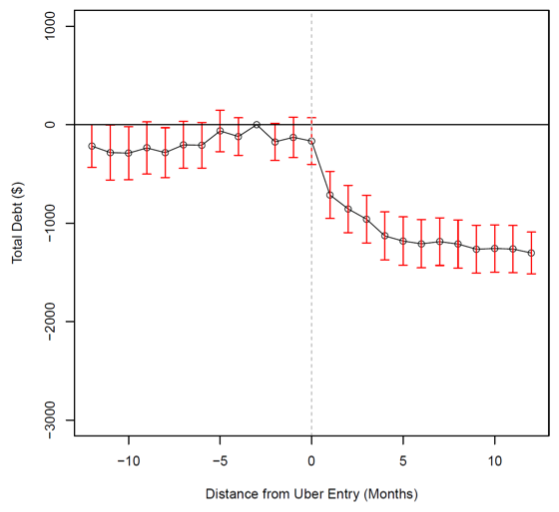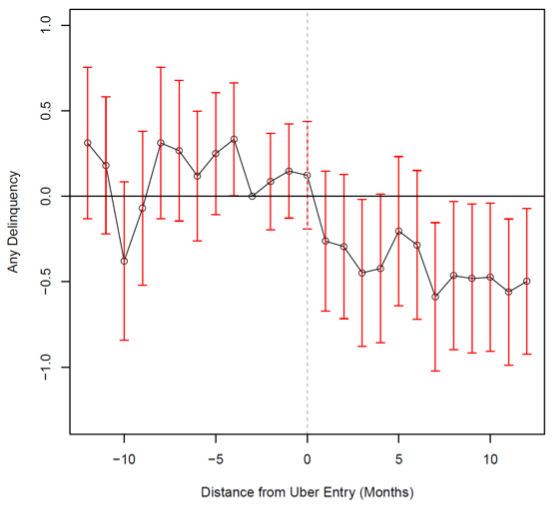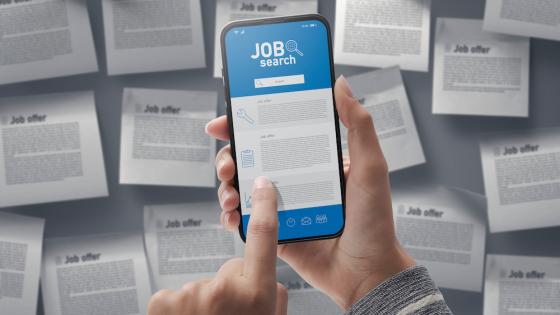The gig economy has grown rapidly over the past few years, fuelled by advances in technology. In 2018, over 57 million US workers participated in the gig economy, with participation rates expected to reach 43% of the US work force by the end of this year.1 Ride-sharing platforms like Uber and Lyft have contributed to this growth, employing four million workers in 2017 – a number that has doubled over the past two years.
The policy debate
The increased participation of workers in the gig economy has sparked debate over how to regulate large employers of gig workers. Critics argue that gig-based employers don’t provide an adequate safety net for workers (e.g. health insurance or social security benefits), classifying workers as contractors rather than full-time employees. California recently passed Assembly Bill 5 (AB5), which will require companies to reclassify independent contractors as employees. Companies including Uber and Lyft have challenged this law in the courts, and litigation is currently in progress (e.g. Marshall 2020).
While individuals who work exclusively in the gig economy don’t receive insurance benefits, the gig economy can still provide a form of insurance for individuals who participate in the traditional labour market. Koustas (2018) shows that workers primarily employed by a traditional firm treat the gig economy as a secondary source of income, to be used when there is a shortage of available hours at their primary job. Relatedly, we examine how the gig economy acts as a form of private unemployment insurance when a worker is laid off from his or her formal employment. Our results suggest that gig labour provides an important safety net for recently laid-off employees as they search for another job in the formal labour market.
Typical response to lay-offs
The idea that individuals prefer a smooth consumption stream to a lumpy one is a pillar of microeconomics (Keynes 1936, Modigliani and Brumberg 1954, Friedman 1957, Hall 1978). The preference for a stable and predictable path of consumption is especially pronounced for those experiencing a shock to their income. This preference acts as motivation for government policy, such as the broad deployment of unemployment insurance (UI). It also helps explain a consumer’s increased reliance on credit-based debt during an unemployment spell. Given that a large fraction of households do not have precautionary savings, unemployment insurance and access to credit are critical to helping a household smooth out consumption patterns during unemployment spells.
Yet, neither option is ideal from the viewpoint of economic efficiency. The presence of a social safety net may distort an individual’s incentive to seek re-employment. At the same time, an increased reliance on credit may intensify downturns, such as when borrowers strategically defaulted on debt obligations during the recent financial crisis. Each tool acts as a half-measure because neither is able to address the root issue: the existence of frictions that prevent a newly unemployed individual from readily being re-matched in the labour market.
Role of the gig economy
We examine whether the introduction of the gig economy reduces such frictions, altering the way employees respond to job loss. Using a comprehensive set of Uber product launch dates and employee-level data on job separations, we find that laid-off employees with access to Uber are less likely to rely on unemployment insurance. Figure 1 shows this decline by comparing the likelihood of receiving UI benefits for laid-off employees who have access to driving for Uber to those who don’t. The estimates show that following Uber’s entry into a market, workers with access to the ride-sharing platform are 4.8% less likely to receive UI benefits. Back-of-the-envelope calculations suggest that the decrease in UI usage translates to a yearly reduction of between $492 million and $750 million in UI benefits distributed by government agencies.
Figure 1 Changes in the monthly probability of receiving UI benefits
We find analogous effects when considering credit usage: laid-off workers experience a relative decrease in total outstanding balances of $544, or 1.3% of the average individual's debt burden. Figure 2 highlights this decrease for employees with access to Uber following a job loss.
Figure 2 Changes in credit balances
Finally, we find that the effects of the ride-sharing platform extend to credit performance, with workers experiencing a relative decrease in delinquencies of 2.9%. Figure 2 illustrates this effect. To the extent that credit delinquencies are associated with negative welfare implications, this last result is consistent with a substitution from traditional means of buffering unemployment shocks towards a gig-based labour supply that allows some laid-off workers to avoid the costs associated with unemployment insurance and increased credit usage.
Figure 3 Changes in delinquency rates
What drives the effects of Uber?
Do workers view Uber as a short-term alternative for a recently lost job, to be used while seeking gainful re-employment elsewhere? Recent historical episodes suggest that many workers experiencing an income shock treat the ride-sharing platform as a short-term option. Following the two most recent government shutdowns, accounts of government workers moonlighting in the gig economy were widely publicised by the media and policy makers alike. If this view is widely held, the introduction of Uber (and other gig-economy based firms) represents a structural shift in labour markets likely to benefit laid-off workers for an extended period following Uber’s entry. An alternative explanation is that workers view Uber in the same light as a traditional firm, providing another set of long-term jobs. We perform a series of tests to distinguish between these two views.
First, we focus on the horizon of the effect of Uber's entry. If workers view Uber similarly to a typical firm, its entry may simply provide a one-time set of new job vacancies that recently unemployed workers are able to fill. This would suggest a transient effect, which subsides as the initial vacancies are filled. In contrast, we continue to find a decreased likelihood of a laid-off worker receiving UI benefits or increasing credit balances two years after Uber enters a local area. In a second test, we focus on a subset of individuals who are less likely to view Uber as a long-term employment prospect. Specifically, we find that Uber’s entry has a similar effect on UI and credit usage when considering only those individuals who regain formal employment at another firm within 12 months of the initial layoff. When we focus on workers residing in above-median income ZIP codes using IRS statistics, we find similar results. Laid-off workers residing in such areas, which have an average yearly household income of over $90,000, are arguably less likely to view Uber as an alternate form of permanent re-employment. Finally, we exploit geographic variation in UI benefit generosity across states. If a worker treats Uber as a short-term solution and potential substitute for UI, this trade-off is likely to be influenced by the potential UI benefits available. On the other hand, if Uber is viewed as long-term employment, then the generosity of short-term UI benefits should not impact the decision to participate on the platform. We find that the effects of Uber's entry are stronger in states with less generous UI benefits.
Conclusion
Overall, these results demonstrate the substantial role the gig-economy plays in reducing labour market frictions, and the ensuing effect on a worker's response to job loss. It alters labour market dynamics by increasing the pool of easily accessible short-term jobs. Further, the mechanism highlighted here represents a structural shift in labour markets likely to benefit laid-off workers for an extended period of time following Uber’s entry.
References
Fos, S, N Hamdi, A Kalda and J Nickerson (2019), “Gig-Labour: Trading Safety Nets for Steering Wheels”, Working Paper.
Friedman, M (1957), “The permanent income hypothesis”, A theory of the consumption function Princeton University Press: 20-37.
Hall, R E (1978), “Stochastic implications of the life cycle-permanent income hypothesis: theory and evidence”, Journal of Political Economy 86: 971-987.
Keynes, J M (1936), The general theory of employment, interest and money, Kessinger Publishing.
Koustas, D (2018), “Consumption insurance and multiple jobs: Evidence from rideshare drivers”, Working Paper.
Marshall, A (2020), “Now the Courts Will Decide Whether Uber Drivers Are Employees”, Wired.
Modigliani, F and R Brumberg (1954), “Utility analysis and the consumption function: An interpretation of cross-section data”, in K K Kurihara (ed.), Post Keynesian Economics, Ruthers University Press
Endnotes
These stats can be found https://www.forbes.com/sites/tjmccue/2018/08/31/57-million-u-s-workers-are-part-of-the-gig-economy/#3b343e3a7118 and https://money.cnn.com/2017/05/24/news/economy/gig-economy-intuit/index.html










